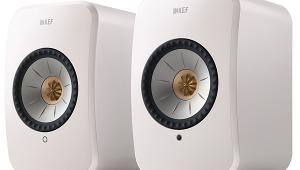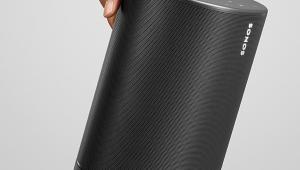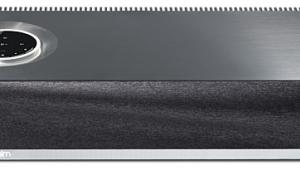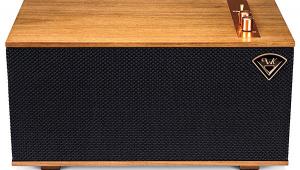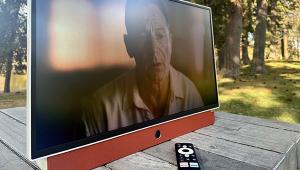I have one of these setup in the corner of my dining room angled so that it plays music towards the kitchen one way and the living room the other way. I am shocked every-time that it is on and I am walking around back and forth through the rooms and it almost always sounds wonderful. Absolutely perfect speaker for background music listening.
Sonos PLAY:5 Wireless Music System Review

AT A GLANCE
Plus
Auto-senses and adjusts output for vertical and horizontal orientations
Trueplay room EQ
Capacitance touch controls with audible feedback
Pure butt-kicking sound
Minus
Slight high-frequency edginess when used vertically
Tiny feet bumps are visible on sides of speaker
THE VERDICT
The Sonos PLAY:5 gets a radical makeover that adds $100 to the price but combines an amazing user experience with stunning audio performance.
Here’s the bad news: After six years, Sonos has stopped making the company’s first and, until now, best all-in-one wireless speaker system, the PLAY:5. Now for the good news: Sonos has a replacement for the PLAY:5 called…wait for it…the PLAY:5. (Confusing, I know.) At $499, though, the new PLAY:5 is $100 more than the original. For multiple reasons, the original PLAY:5 was my all-around favorite wireless speaker. Will its replacement prove worthy of its heritage—and the higher price?
The basics of the new PLAY:5 are much like the old PLAY:5 (which I’ll call the PREV:5 to avoid the repetitive new/old/original/etc). The all-in-one form factor with the curved front grille is similar, although the PLAY:5 is about 1.25 inches deeper and, at 14 pounds, almost 6 pounds heavier than the PREV:5. The PLAY:5 retains the auto-detecting 3.5mm analog audio input jack, the ability to operate singly or as a stereo pair, an Ethernet jack should you choose to use it (the PREV:5 had two to daisy-chain to a second Internet-connected device), Wi-Fi, and SonosNet mesh network connectivity. Current versions of the Sonos apps control the PLAY:5, and the speaker is fully compatible with Sonos’s new, groundbreaking Trueplay room tuning feature (more on that below).

The differences are too numerous to cover in depth, which is a shame considering the amount of laudable, extremely meticulous effort that went into nearly every detail of the PLAY:5. The front grille, for example, is a marvelous piece of design and engineering. In order to avoid interference with the six internal antennae, the grille is plastic; but it’s the most rigidly constructed and braced grille you’ll ever see, despite the fact that the face has 60,000 individually drilled holes. The Sonos logo—which, for a variety of reasons, ended up directly in front of the middle tweeter—is acoustically transparent thanks to 800 laser-drilled holes. The flowing looks and luxurious feel of the AC power cord, and even the way it attaches to the back of the PLAY:5, make me feel sad that it’s normally out of sight.
Like the PREV:5, the PLAY:5 is designed to perform oriented either horizontally or vertically. The PLAY:5, though, has a built-in accelerometer that senses the orientation and automatically adjusts the speaker’s DSP parameters accordingly. Small, unobtrusive, rubberized feet are preinstalled on three sides of the PLAY:5, so you can change the speaker’s orientation without fussing with peel-and-stick bumpers (though this means they’re typically visible on the exposed sides of the speaker). The PLAY:5 has capacitive touch controls on the top (when horizontal) that are a true pleasure to use. To avoid confusion, the control functions swap locations depending on which side the Sonos logo is on when the PLAY:5 is vertical. The upper control, for example, is always volume up/skip ahead, regardless of orientation. Since there’s no tactile sensation, a noticeable-but-not-obnoxious tone plays through the speaker, providing audible feedback when the controls are touched. The overall user experience is so well crafted and refined that I felt like I should be wearing white gloves to avoid leaving fingerprints on the cabinet’s sleek surface.
Inside the PLAY:5’s sealed enclosure are six drivers (three midbass and three tweeters), each with a dedicated amp, instead of the PREV:5’s ported-cabinet, five-driver/amp configuration. The left and right tweeters have outwardly angled waveguides to increase the width of the soundstage. Sonos says the tweeters, midbass drivers, amps, DSP circuitry, internal antenna arrangement, and damn near everything else were custom-designed for the PLAY:5. Although not active yet, there are also two microphones mounted in the front baffle for potential future use.

The PLAY:5’s acoustic performance didn’t exactly live up to the speaker’s appearances, though. Instead, the sound quality of the beautiful-looking and delightful-to-use PLAY:5 absolutely surpassed the already lofty expectations I had. The bass response is remarkable for a speaker of this size and intended use—so much so that I never yearned for a dedicated subwoofer, even for bass-intense tracks such as Jennifer Warnes’s classic “Way Down Deep.” If anything, the PLAY:5 may have been a tad bass-heavy in its default settings, but that’s easily rectified via a simple EQ adjustment. The PLAY:5 is wonderfully tight and responsive, too, handling the snap and tension in Marcus Miller’s bass guitar on “Tightrope” (with Dr. John) from Renaissance without strain or fatigue. The upper frequencies of the cymbal and piano work in Fourplay’s “December’s Dream” (Esprit de Four) were sweetly reproduced when the PLAY:5 was horizontal, though it suffered from a slight edginess when placed vertically.
One thing that impressed me with the PLAY:5 was how big the speaker sounded. It’s capable of filling a large room with excellent bass output and an incredibly wide soundfield that’s almost impossible to believe comes from a single speaker. Just as amazing is how consistently excellent the PLAY:5 sounds when you walk around the room—and that’s before using the Trueplay tuning.
Trueplay doubles down on the PLAY:5’s already amazing performance by correcting for the speaker’s typically crummy room placement in kitchens, bedrooms, and bathrooms, where there are often hard surfaces and reverberant acoustics. It works with all Sonos speaker systems except the PLAYBAR soundbar (but including the PLAY:5, PLAY:3 and PLAY:1). Setup takes only 60 seconds of walking around the room waving an iOS device up and down. Best of all, it’s free with the cost of the speaker.

I’ve tested Trueplay on different Sonos speakers, and it overcame some truly awful locations such as on a countertop against the microwave, on the bottom shelf of a nightstand, and even behind the door of a kitchen cabinet. For example, I set the PLAY:5 on my kitchen counter under a cabinet hanging less than 5 inches above the speaker. To further screw things up, the PLAY:5 was sitting up against the backsplash with a large bowl of fruit and a wicker basket full of candy in front of it. Pre-Trueplay, the bass was fat and tubby, sounding like the speaker was sitting inside a box—which, essentially, it was. Vocals were muddled, while the high frequencies were harsh enough to scrape all the wax out of my ears. Even though the Sonos app told me that the speaker didn’t need much processing when the calibration was completed, after applying Trueplay, the results were astounding. The bass response tightened up considerably, and all of the tubby, muddled midbass and vocals were reined in. The highs lost all of the edginess yet remained clear and crisp. The PLAY:5’s bass didn’t extend quite as low as it did out in the open, but that loss is nothing compared to the rest of the performance gains Trueplay brought to that placement. Even knowing what to expect, my eyes simply didn’t believe what my ears were telling me.
I’ve always thought highly of the Sonos components and the Sonos ecosystem. The new PLAY:5, though, takes things to a significantly higher level, one that neither sacrifices sound quality for convenience nor convenience for sound quality—and, for that, $499 is truly a small price to pay. If this is the direction Sonos will follow with all its future components, the other streaming speaker system companies had better beware. The bar hasn’t simply been raised. It’s skyrocketed upward. All things considered, without a single doubt, the new Sonos PLAY:5 is a SERIOUS:10
- Log in or register to post comments


$500 for background music listening?? And it doesn't do hi-rez?? Double-WOW!
Since I utilize DLNA for photos, HD video, and music (including hi-rez), I personally couldn't justify $500 for an additional, single speaker that locks me in to proprietary tech. (Am fairly confident one can find a pair of comparably-, or even lower-priced bookshelves/monitors that have a better SQ than the PLAY:5.)
Clearly, it's more mobile than a wired set of speakers, but just how frequently does one move his PLAY:5 around??
Are lifestyle products like these *THAT* much more important than audiophile-quality sound??

Are the CONVENIENCES of lifestyle products like these *THAT* much more important than audiophile-quality sound??

Is not intended to get an audio-phile to replace their setup with these. I think the play-5 is more targeted at a music-phile who wants there music to be convenient and sound really good. It definitely doesn't replace or is better than a good stereo setup. My 2.1 system which is not fancy at all, sound better. But the ease of throwing some music on the Sonos while cooking dinner, cleaning up and eating or just hanging around is un-matched. And with the Play 5 it actually sounds very good and much larger than you would expect.

I love this article very much..Specially the music is very soulful and getting me in touch with soothing around. I like the way you showed. I am a huge fan of sound vision and moreover I daily get updated with these website. Best Legal steroids United Kingdom Click here to buy. I love the website for trenbolone, dianabol, Anavar, clenbuterol etc. buy from our online store.

I am following your posts and they are really good each and every time. your writing style is really good.
Sandra
HGH for Sale

It is a great product, great design, awesome sound. I really love it. At the cost of $499 it's not cheap but it worths it. KouTea


